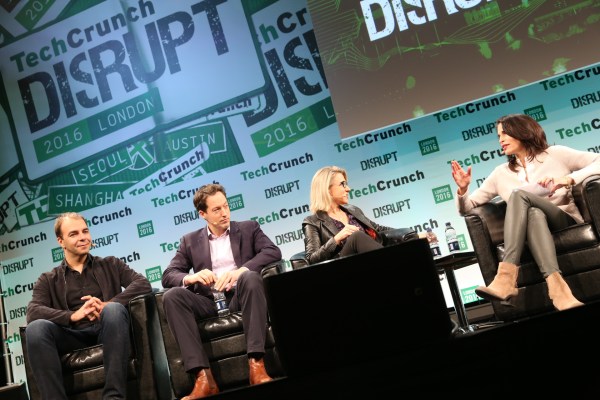While the IPO window might be quite a little more narrow these days and there’s plenty of uncertainty, it doesn’t necessary mean the end of the venture capital world — at least, not yet.
Instead, it would seem that a lot of the VC world is in a holding pattern while they wait for everything to shake out — whether that’s for additional private capital to return, the opportunity of IPOs to widen or for the global political environment to become more clearly defined. Elizabeth “Beezer” Clarkson of Sapphire Ventures, John Doran of TCV and Fabrice Grinda of FJ Labs joined us on stage at TechCrunch Disrupt London 2016 and, as you might expect, echoed the same thing.
There was one common refrain from the members of the panel: it was far too early to tell what would happen following a set of largely unexpected political shifts like the United Kingdom’s decision to withdraw from the European Union and the election of Donald Trump as president of the United States. Investors, obviously, hate uncertainty — but for the large part even with their uneasiness they are trying to remain patient before determining whether or not it’ll end up being a negative for the ecosystem.
“It’s so hard to know what will happen that it’s speculation,” Clarkson said. From an LP perspective you’re investing in other investors, and you pick people who can manage through ups and downs. Administrations do come and go every 4-8 years and the tech ecosystem keeps moving forward.”
But even amid that uncertainty, there are huge markets that have yet to be fully tapped by startups just yet — particularly education and health. These have been notoriously difficult markets to enter given stiff regulations and a high barrier for adoption, but those represent plenty of opportunity, they said.
“We’re still in the beginning of the digitization of the world, Grinda said. “We have the entire [markets that] have not yet been touched by the digital revolution [like education and health]. We’re seeing those attacks by startups vertical by vertical. I’m less optimistic about the IPO market going up. Do I think the M&A market will continue to be frothy, absolutely. Because digitization, many companies like GM and other categories, they haven’t transformed themselves, they need and are hungry for tech companies to help them and come to the 21st century.”
In recent years, we’ve also seen a lot of larger company funds and corporate investing flood the market — leading to companies like Fidelity getting into companies like Zenefits and Dropbox and subsequently marking them down. That’s pared back a bit, though when larger corporations are looking into investments they can also focus on the technology and not necessarily place large pressure to exit, Clarkson said.
“If you look at the macro perspective we’re in a low-interest environment where people are yield-chasing,” Grinda said. “Technology is the main provider of productivity and economic growth globally today. Even though fair weather investors took a step back in 2016, I suspect the frothiness and desire to invest in this category will continue for the future. We’ve seen people focus on unit economics versus growth at all costs, and it’s a good thing.”
Eventually, these companies are going to have to try to get their things in order and more readily go public rather than gunning for smaller exits or relying on a dearth of private-market capital. There are obvious benefits to not going public — companies are outside of the traditional scrutiny that public companies face and the nearly daily pressure of people following a stock price. But having a wide array of companies going public and being successful in the end is good for the technology ecosystem, Doran said.
“You have easy access to capital, so why go through the pain of being public and report and be transparent?” Doran said. “In the last 2-3 years, you’ve seen a lot of companies raise at very high valuations, and going public may be a down round. That’s harder to do in the public eye. I think it takes a constitution it takes to be a public company CEO. There are rules and regulations that have gotten stricter. On the flip side you’re seeing a movement to make it easier to go public, but I’m not sure those have been solidified.”
